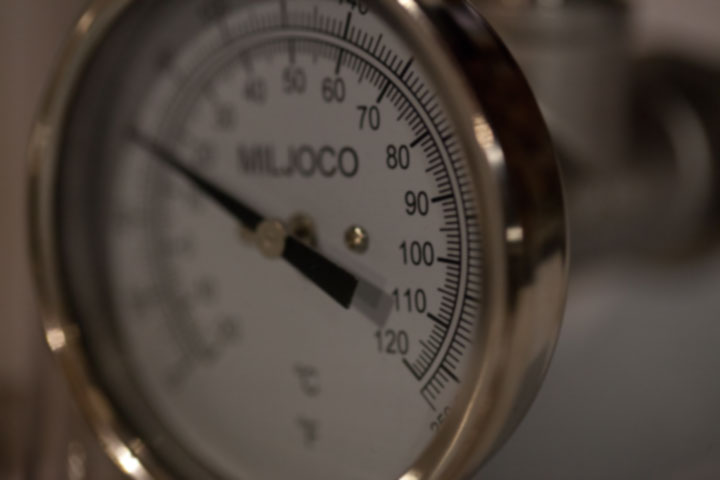One of the most common useful pieces of equipment in the home brewery is the thermometer. Measuring, monitoring and ultimately, controlling temperature is a key aspect of producing quality beer. It starts with making sure that the water is being heated to the correct temperature for mashing and later on for sparging. It continues with getting the boiled wort cooled down to an appropriate temperature to pitch the yeast. After fermentation and carbonation, the beer needs to be cooled down to the correct serving temperature. These key steps and many in between all depend on the trusty thermometer for accurate results.
Thermometers come in many shapes and sizes. The two most common categories are analog (mercury) and digital. While handy to have around in case of emergency or for calibration purposes, the former should generally be avoided in the brewery. It simply isn’t worth the risk of broken glass or mercury ruining a batch of beer should the thermometer be accidentally broken while taking measurements. Digital thermometers have the advantage of less fragile metal probes, easy to read displays, and can provide quicker readings than their analog counterparts. The digital category is also further broken down into pen style and probe style. While the pen style is convenient for taking quick measurements, the probe versions often have additional features such as built in timers, temperature alarms, and replaceable probes.
Another option is the infrared thermometer. This is a non-contact style of thermometer which measures thermal radiation. This type of thermometer also usually has a laser sight built into it for easy aiming. Their non-contact method – up to several feet away from the source being measured – of temperature measurement offers several advantages. There is no risk of contamination or infection from a thermometer that would otherwise need to be sanitized and immersed in beer in the cold side (post boil) of the brewing process. At a distance, a wider range of temperatures can be measured than with thermometers that must be directly subjected to those temperatures. High temperatures that could otherwise melt a probe thermometer can be safely measured at a distance.
When it comes to brewing vessels, analog dial thermometers can often be found installed on boil kettles, mash tuns, and hot liquor tanks. While these are a good tool to have for monitoring the temperature of those vessels, having secondary measuring devices is always a good idea. Even the best dial thermometer can get stuck or drift out of calibration at the most inopportune time during the brew day.
Automated brewing systems also commonly feature devices known as RTD’s or Resistive Temperature Detectors. These are essentially probes which vary their resistance based on their temperature. While RTD sensors don’t directly provide a human readable output, they are typically paired with a controller device capable of translating the voltage resistance of the sensor into a known temperature and displaying it. Sometimes thermometers and controllers are sold as a single assembly used to control a power source. These devices come in both analog and digital forms and are commonly used for maintaining temperature in beer refrigerators (e.g. kegerators and keezers) by turning them on and off based on the temperature for which they have been programmed.
The same system can also be applied at the fermentation stage to maintain a constant temperature for the beer being fermented. This may be applied as a single stage in an environment where the ambient temperature is colder than desired by programming the temperature controller to turn on when the temperature falls below a certain threshold. The power output of the controller is connected to a heater (e.g. a heating pad) to raise the temperature of the fermenter. Once an upper threshold is reached, the controller turns off the power output. Some controllers may also support two stages where a second cooling device can be powered when temperatures fall below or above the programmed threshold temperatures.
A type of thermometer called a fermometer can sometimes be found on the side of fermentation vessels. These are adhesive liquid crystal strips that can be stuck to the side of a bucket or plastic bottle. As the temperature of the beer fermenting inside changes, the color of the plastic strip changes to indicate the temperature as defined by the scale printed on it.
Calibration
No matter what kind of thermometer you have, the most important factor is to make sure that it is properly calibrated and provides accurate results. A thermometer that displays a temperature 10 degrees higher or lower than the actual temperature can be no less disastrous as having no thermometer at all. It might even be considered worse since it instills a false sense of confidence in the brewer’s process.
Calibration is simply a matter of measuring known temperatures and comparing the measurements to what their expected values should be. The most common mediums are pure ice water and steam. The freezing and boiling points of water are well known and provide good benchmarks at both ends of the scale. If the measurements don’t match then it should be possible to come up with a conversion factor. Any temperature measured with the thermometer should have that factor applied in order to determine the actual temperature.
Another useful procedure is to compare the measurement of the same substance with several different thermometers. Even the same model of thermometer can produce different measurements. It is also important to occasionally test your thermometers to make sure their accuracy has not changed over time.
